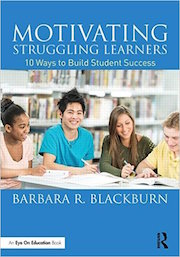3 Ways to Encourage Ownership of Learning
Do you remember the first time you made a major purchase or invested in something really big that was yours? For me, it was my first car. I worked several summers as a lifeguard to save enough to buy a small red Toyota.
It took all of my savings, but it was mine. I washed it, took care of it, and had a special pride in knowing that it was mine and that I had worked for it.
What about your students? How do they view the classroom? Is it yours, and they are simply renting space for a short time? Or do they feel like they own it with you, that it is our classroom?
That may sound funny, but go back to your personal experience. How do you feel about things you own? My guess is you have extra stick-to-it-ness—a longer-term view about things you own. You are more invested in taking care of them and making them better.
Students in classrooms where there is a sense of shared ownership have the same feeling. They love coming to school, and as one student told me, “It’s my class, and if I’m not there, I’ll be missed!”
Don’t just expect students to claim ownership
You might be thinking, “I’ll take the ones who want to be here, and for those others, well, after all, they are just here a year. If they want to have that attitude, it is okay with me; it is their choice. I can wait them out, too.”
But helping students establish ownership is really important to YOUR success, too. A key part of motivation is feeling a sense of ownership in what is going on. Consider that students spend almost a third of every day in school. That is a lot of time!
I talked to a parent who said, “We’ve just resigned ourselves to having a bad year. Michael just isn’t ‘into’ school this year.” We know that for many students, particularly those who are not performing on grade level, it takes several years to make up for one bad year or for one year with a less effective teacher. Part of being effective involves your invitation to students to become co-owners.
Ownership is a characteristic that takes time to encourage, but you can build it by focusing on three specifics: choice, voice, and leadership.
1. Build ownership by offering choices
Offering choices is one of the simplest ways to encourage student involvement in your classroom. Unfortunately, I talk to many teachers and students who don’t feel as though they have any choices at all.
I talked to one student who told me he felt like school was a place where “they tell you what to do all the time.” Feeling a lack of choice is disheartening and frustrating for anyone. There are many opportunities for students to have choices in your classroom.

I was in an alternative school where students felt they had no choices. The English teacher was planning a unit on Shakespeare. As she and I talked, she realized that allowing her students to choose a final project would encourage stronger participation from them. However, she was uncomfortable simply letting them come up with whatever they wanted to do.
So she began by allowing them to explain the literary work by choosing from a list of appropriate projects, such as painting a mural, creating a music video, designing a commercial, or writing a children’s book.
You could offer these options with just about any assignment you do, no matter the subject. Imagine the depth of understanding needed for a student to explain a concept in a two-minute commercial or the creativity involved in developing a music video to explain content. If they are allowed to choose how they show you they understand the content, many students will invest more time and effort on the task.
2. Build ownership by encouraging voice
Student voice is actually taking the notion of choice to a higher level. With choices, you are still the primary decision maker, and you are allowing students to make some decisions, usually within some parameters. Voice is about students truly sharing in the decision-making process.
Adam Myers, a language arts teacher at Coulwood Middle School, employed a controversial approach to spur his students to use their voices to express strong opinions. In the middle of a novel study, Forged by Fire by Sharon Draper (the story of a young boy’s life as he attempts to protect his younger half-sister from mental, physical, and sexual abuse from their stepfather), Adam hid the books.

Then Adam encouraged students to write letters to parents, the principal, the governor, or the president expressing how they felt about the book and what happened. All agreed that the novels belonged in their hands – no one had the right to take them away.
He then told them he was just kidding. Here’s what he said about the experience:
I like to think of their laughter and comments about their mean teacher as relief that the books were still going to be a part of the classroom. What amazed me most…were the answers I received when I asked them why they thought I would do such a thing.
It was in this conversation with my students that I saw that I had truly used literature and writing to help my students both academically and developmentally. They were attached to the characters and felt cheated that they wouldn’t know the end of the plot.
They took ownership of their writing as they justified that although the novel was controversial, it allowed them to explore a realistic situation that unfortunately was too close to some of their friends, classmates, or family members. My students have not forgiven me, and that is o.k. because I’m sure they will never forget me.
What a powerful lesson. He tapped into students’ strong feelings of justice and choice with a real-life example of censorship to spark ownership of an issue. Although a controversial activity, it clearly had a lasting impact on his students.
3. Build ownership by encouraging leadership
A final way to build ownership is to provide opportunities for each student to be a leader in your room. I think the best, most consistent examples of this happen in early childhood classrooms.
There is a leader for the day listed on the board. Or there is a chart on the board and it lists several leaders for the day: the lunch line leader, the calendar leader, the recess leader, and so on. Every child has a specific role, and the teacher rotates those regularly. In that particular classroom, everyone is a leader at least once a week.
Gin Sorrow, a middle school teacher, shared a leadership story with me:
I had some very social and unmotivated girls that were negative leaders in a class. I challenged them to teach the next section. They would come early in the mornings and work with me during planning times to prepare the lessons. It was a wonderful experience.
I was able to see some of their methods for connecting with their peers that I could incorporate into my teaching the rest of the year. The girls grew into more positive leaders and challenged the other students to improve. It is definitely a strategy I would use again.
Many teachers use more formal structures, such as electing class officers. Tamara Willis, seventh-grade social studies teacher at Sullivan Middle School, chose a similar approach after her students complained, “School is like a job and…we should get paid for attending.”
They voted to create a business, which was named Sullivan University. Students prepared resumes and applied for positions (Dean, Professor, and Intern) and interviewed one another for the jobs. Those students who were hired to be deans held an executive board meeting with Ms. Willis to form teams and design new classroom rules to address issues related to poor behavior and absenteeism.
As the experiment continued, students began to demonstrate leadership by quieting their peers when they were disruptive. The result? Attendance increased, students were more engaged in instruction, and discipline referrals decreased.
All these examples have one thing in common: The teachers chose to channel students’ negative behaviors into positive actions, tied to leadership development.
Shared ownership is a win-win
Ultimately, you have the final say in your classroom. After all, you are the teacher. You’re the CEO of Learning. But as the most successful executive leaders will tell you, if you are willing to share some ownership with your “employees,” you will create a true community of learners, and you will also reap the benefits. Not only will your students want to come to class, so will you.
__________





































Is this student directed choice or teacher directed choice. ‘What do I want to learn about? How can I show my new learning? or How can I build new knowledge?’ 5 year olds do this beautifully…. what happens in our systems as students get older?? Believe children can make these choices that they all have this capability- then support those who need it.
Exam formats and time restraints limit choices for teachers and students. If only the exam offered the choice of painting picture, creating an advertisement or rapping a rhyme.
I like the way that the teacher was willing to give his student ways to express themselves
I like the way of giving the pupils an opportunity to talk about themselves and feelings. I used it in my classes so much.
I loved the ideas. some can work in my school and some I would need to change. I would love to try and practice them in my classrooms.
It is a motivating article with good points and recommendations that I would try to make my own in my class room.
Very clear article, the things are said on point. I always give a choice to my pupils during the lessons, especially the way to present the final product. But I need to encourage them more to be leaders, this way they will feel partners in the learning process.
I really enjoyed this article. Gave me a plethora of ways to engage my students.
Great points but how to apply them to ESL students who haven”t yet mastered the English language. I would like some examples that enable me to use class collaboration/shared learning in ESL classroom.
Please give these MiddleWeb posts by Tan Huynh a look:
https://www.middleweb.com/45326/what-learning-in-two-languages-looks-like/ and https://www.middleweb.com/44464/transforming-learning-with-translanguage/
Susan at MiddleWeb